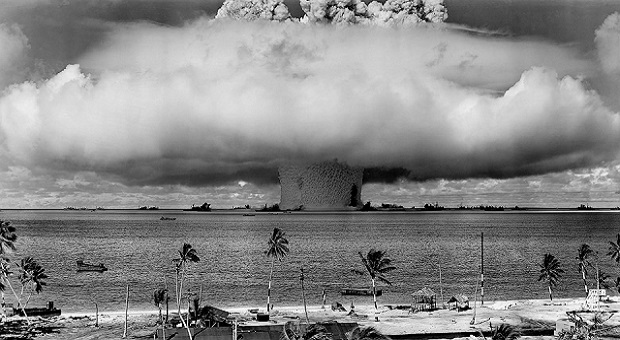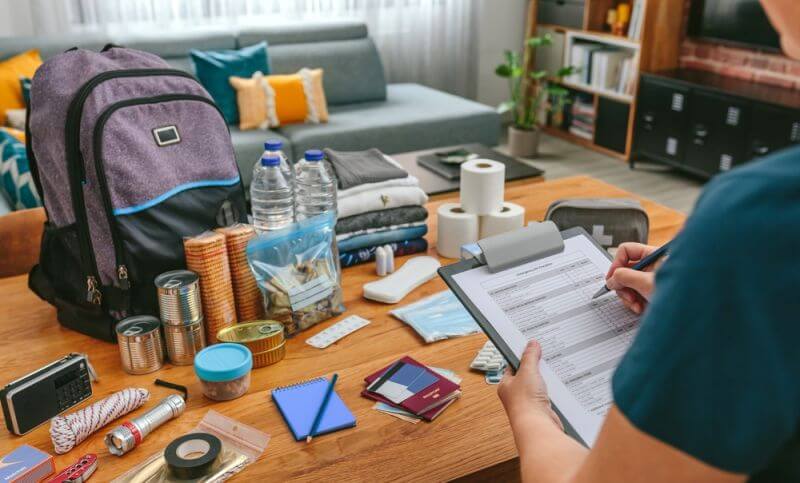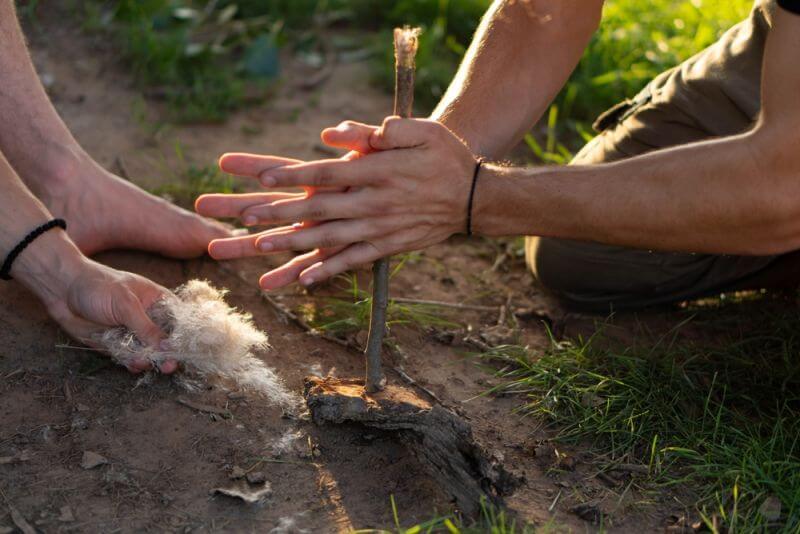With the North Koreans gathering plutonium for nuclear warheads, and their Supreme Leader unhappy with Trump’s ascension to the office of President, nuclear preparedness should be everyone’s concern. How to stay safe while bugging out makes part of this plan, for sure.
Even someone that can navigate by looking at the sun or using other “low tech” means can easily fall prey to radiation poisoning after a nuclear incident. In fact, people interested in bugging out or moving from one area to another might be at higher risk than those who are staying in one area.
So if you are in an area where more nuclear incidents are likely to occur or you need to travel for some other reason, safe navigation is extremely important.
While the basics of using maps, compasses, and other tools will not change, your path from one point to another may be far more different than expected. In particular, you will need to know more than how to skirt around areas where radiation intensities are highest.
You will need to know how to predict where radioactive materials are most likely to disburse as well as how shifting weather and tide patterns will affect where additional materials will build up. This is even more important if you intend to gather water and food along the way and happen across what appear to be low or non-contaminated areas.
Calculating Rate of Radioactive Travel By Land
Calculating how fast nuclear radiation will spread over land is no more difficult than knowing how fast breezes and the wind will move from ground zero to your location.
First, you must know the source of the radiation. You can use the links we posted at the end of the article to test out different areas and nuclear yield in order to get some idea about how large an initial area will be affected. Next, study the predicted wind currents for the area surrounding the contaminated site. Use the national climate archives to figure out the general wind direction for each state during specific months, as well as for major cities within each state.
For example, if you want to know how a nuclear blast in Alameda, California will affect Los Angeles CA, you might start off by visiting the Western Regional Climate Center, and then click on Average Wind Direction by State. You’ll see that the winds in Alameda usually go to the West, and in January they tend to go towards the NNW. Since Los Angeles is roughly Southeast of Alameda, you could go from Alameda towards Los Angeles for most of the year and more than likely escape fallout from the nuclear zone.
Unfortunately, since the wind from Alameda moves to the SE in December, you would not want to try and escape to Los Angeles as the nuclear radiation would follow you or precede you out of Alameda.
If you have a bug out plan that lists this information, you can also use real time estimators of wind current to project how fast the radiation is moving. Use the Beaufort Wind Scale to help you figure out how local winds are moving. If you get contradictory information between the historical tables and your observations, it may be best to get underground as quickly as possible and wait a few days to see what the air currents are doing.
Take the time now to observe wind directions and durations in your local area. If you have projected bug out paths, make sure that you have year round information on wind currents in those areas as well as studies on how wind from other areas moves into the ones you plan to travel through.
Calculating Rate of Radioactive Travel by Water
When it comes to calculating the spread of nuclear contamination over land, it can be said that air and its associated wind currents determine both the speed and distance. In a similar way, water acts as the medium of transport when attempting to calculate the rate of radioactive travel by water. If a detonation spreads water and debris into the air, you would need to calculate both the air mass and the water currents.
To calculate the rate of radioactive travel by water, start off once again by visiting Nuclear Secrecy so that you can get some ideas about how large the initial impact area will be. Then you will need to look at charts of the tides, water currents, and wind directions in the area.
There are two free resources that may be of some help to you. First, Open Nautical Chart offers global charts that also provide information about global wind and precipitation patterns. You can try using this chart for predicting how nuclear contamination will spread over areas of both land and water just by looking at the general trends. For more specific information about the currents and tides around the United States, visit Office Coast Survey.
Once you have the maps, all you need to do is compare the information between where the nuclear fallout is, and the maps will show you where it is most likely to go. For water calculations near the coast, you may also want to take the daily tides into account. For this, visit Salt Water Tides, and then select the region and date of interest to you. You can also use this site to project future tide timings.
Mountains and Other Geographic Mitigating Factors
Even though you may be aware of seasonal changes in precipitation types or storm intensities, you may not realize that wind patterns also have seasonal and predictable fluctuations. Aside from that, mountains, hills, valleys, and other geological features can alter the way both wind and rain will affect any given area.
When it comes to getting away from nuclear fallout, you can think of mountains and hills in two ways. First, you can think of them as shields that you will want to put between you and the source of the radiation.
Typically, both wind and precipitation contaminated by nuclear materials will fall on the side of the mountain closest to the blast. As with everything from hurricanes to snowstorms and other weather systems, the precipitation-bearing clouds will drop in temperature as they try to move over the mountains.
This, in turn, will cause them to a good bit of water before they reach the other side. In some areas where this effect is especially pronounced, you may notice that rainfall data is less than it is on the other side of the mountain. The “drier” side of the mountain will be safer in a nuclear crisis because prevailing rain patterns will not carry fallout over to the other side.
Second, you can think of mountains and hills as places where prevailing weather patterns may offer clues about lower fallout risk regions. Excessive dryness on one side of the mountain may indicate that prevailing winds shift in the opposite direction. In this situation, even if the source of radiation is closer to the drier side of the mountain, it may still be safe because the debris will be carried in the opposite direction.
That being said, an area in this situation is also apt to be desert, or at best, scrub lands. If you are considering using an area like this as a nuclear bug out location,visit the area first and make sure that you know how to live in a desert region and be sure that you can secure water on a regular basis.
Locality Based Mitigating Factors
While you are moving from one place to another, it is important to realize that just about anything can act as a shield to nuclear radiation. If you are always aware of wind direction in relation to your location and ground zero, you will have a better chance of knowing when to take cover. While underground locations will always be best, buildings and even a tree can mitigate the amount of radiation that reaches your body.
Just remember to stand or sit in a place where the object is between you and the direction the contaminated air is coming from.
As you move through different areas, you are also bound to need water. If you cannot locate underground sources, some terrains may offer safer water than others. For example, if you are near a pond with bushes or shrubs growing nearby, take note of where the shrubs are in relation to the prevailing wind. If the shrubs stand between the wind (and the nuclear debris it carries), then the water may have less radiation.
The taller the shrubs or trees, and the denser they are, the more protection they will afford. As long as it hasn’t rained since the nuclear blast occurred, the water may be a bit safer than what you would find in other locations. At the very least, if you have no water purification options available you can try using this:
- Start off by taking water only from the uppermost part of the pond. Dust and heavier contaminants will settle to the bottom.
- Let the water settle for at least 24 hours so that any additional radioactive material will settled towards the bottom of the pitcher.
- To get rid of any bacteria or pathogens, it is best to let UV light from the sun kill them off. It is best not to boil the water in this situation because it will only concentrate any dust particles that remain in the water while the lighter water molecules escape.
If you come across a moving stream or river, be very careful about the direction of the water flow in relation to the fallout zone. Even though moving water will dilute the nuclear material, it is best to seek a water source that is upstream of the blast. As with ponds, the more shields and distance that exist between the water and the nuclear site, the better.
Areas to Stay Away From at All Cost
Did you know that there are unsafe areas right here in the United States because the levels of nuclear radiation are too high?
What you may not realize is that the surrounding areas may also be contaminated to a point where they can endanger your health. To make matters even worse, Fukushima and other nuclear accidents may make an area you thought was safe far too dangers for a bug out location. When it comes to navigating after a nuclear disaster, you will need to factor in these locations plus the locations of any nuclear facilities that may pose a risk to your well being.
Source: climateviewer.com
Remember, if our nation is under some kind of nuclear attack, it is also entirely possible non-nuclear attacks may happen at the same time. Large hospitals with nuclear diagnostic equipment, medical waste transports, nuclear power plants, and other sites that have nuclear materials will be a target.
As such, personnel that are best trained to control the situation may also be unavailable. If you try to pass through these areas, the chances of you coming into contact with high levels of nuclear radiation is very high even if the direction of contamination from a nuclear ground zero indicate otherwise. Always remember that nuclear radiation exposure is cumulative. It does not matter where the radiation comes from; only that you were exposed to it.
What About Edibles Along the Way?
No discussion on navigating during a nuclear disaster would be complete without a discussion on how to recognize which foods are safe to eat in an area that might have been impacted by nuclear fallout. While it is risky to eat anything in these areas, you can reduce the risk to some extent by taking the following advice:
- Choose foods that were stored underground first.
- If you must consume plants, use the deepest roots you can find first. It would also be best to choose plants that have not been exposed to rain since the nuclear blast occurred. For example plants in the middle of a patch, or covered by other plants may be safer.
- If fruits and vegetables are available, try to use ones that have skins that can be removed. Smooth skinned fruits and vegetables will be safer to wash off and eat than rougher skinned items.
- Canned foods should be ok; but choose ones in an area that is best protected from the blast direction. Consider a situation where the nuclear blast occurred to your west. If you are in a pantry, you would select foods from the east shelves because the radiation would have to pass through all the cans on the western side before reaching the others. As with transportation, always look for foods where the largest and heaviest shields stand between the radiation and the food resource.
- Avoid dried foods such as beans and fruit. You will find it very hard to wash nuclear debris off them or remove skins that might have captured the radiation. Also avoid leafy vegetables or anything else that you cannot peel or wash vigorously.
How do You Know You are Close to Ground Zero
Let’s consider a situation where a nuclear blast occurs and you must evacuate immediately. As you run to get your bug out bag, something distracts you, and somehow all your maps and important information about wind directions and navigation get left behind.
But thing can go worse than that. You have your cell phone, but you never uploaded these important files (so you wouldn’t have to go online or to the cloud to get them) because you were afraid an EMP would knock the phone out and make it useless. Upon turning on the phone, you realize it works perfectly, but you cannot get online. You have a compass, but never took the time to learn how to use it. Tucked deep in the bottom of the bag, you find a pair of binoculars that can be used to reveal wind direction and cloud formations. Since you don’t remember how to assess wind direction, you conclude the binoculars won’t be much good.
Realistically speaking, if you are in this condition after a nuclear blast and somehow managed to find safe shelter for a few days, you are going to have a fairly hard time finding a viable path to safety.
If you remember nothing else about how to navigate during a nuclear crisis, at least remember the signs and signals that you are at or near ground zero. At the very least you can try to skirt through these areas, avoid eating in them, and try to get out of them as quickly as possible.
Animals and Plants in Distress
Animals may have mouth sores.They may also bleed more from the nose and eyes, and may also show signs of fur loss. Large numbers of animals and insects may be dead and just laying around. Large numbers of fish may also be dead and have open sores on them.
Baby animals may have unusual numbers of digits on their paws. They may also be completely misshapen or have organs growing outside the body.
Animal or human feces may be in the form of diarrhea or have blood in it.
Plants will have tumorous knots on the stems, or unusual leaf patterns. For example, a three leaf clover plant may have five, six, or even seven leaves on a single stem.
The Black Rain
You may find signs of black rain: a combination of nuclear debris and soot from all the fires that happen after a nuclear blast. You may see streaks of thick, sticky black liquid on walls, dripping from trees, or anything else that it lands on. If you look carefully at the ground, you may also see signs of this “rain” laying along the ground. Animals and plants may also be covered with it.
If you encounter black rain, it is extremely toxic, and will most often be found in the debris field surrounding ground zero. Once you encounter this kind of debris, your best bet is to go back the way you came, an then try to choose another direction.
f you are closer to ground zero, permanent shadows may exist to reveal where objects once stood. For example, if you see a tree shadow on a sidewalk, but no tree, that means the tree was vaporized by the blast. The angle of this shadow will reveal the direction of the blast in relation to where the object was. To get away from ground zero, just go in the direction where the tree or object “points”. In this case, just walk in the same direction as where you see the “top” of the tree’s shadow pointing.
You can also get some rough ideas about how far away the object was from the blast. The shorter and more perfectly proportioned the shadow is, the closer it was to ground zero. A longer shadow means you are a bit further away.
Signs of Disaster
Any area that was hit by the heat wave will show signs of having fires. You can expect to see buildings, cars, and many other objects that may be charred beyond recognition.
The closer you get to ground zero, the signs of disaster you will see: walls, buildings, and even motor vehicles knocked over. This damage occurs as a result of the air blast created by the explosion. Since the shock wave bands usually extend beyond other types of damage, finding them is a good indicator that you are either heading into ground zero or away from it.
For example, if you passed through areas that showed signs of being on fire, going through a blast zone might be an improvement. If the radiation shadows are getting longer as you go along, this might also be considered a sign that you are heading away from ground zero.
Tools That Can Help You Avoid Contaminated Areas
Here are a few tools you might find useful:
- Maps listing known nuclear material zones
- Maps of historical wind current
- Maps of water tides and currents
- Long range binoculars
- Small drones or robots that can be used to deliver testing equipment into a suspected area of contamination.
It is often said that if you have a map and compass, or know how to navigate by the sun and stars, you will never get lost. That being said, navigating during and after a nuclear crisis requires far more than simply figuring out how to get from Point A to Point B. Your plans can easily be disrupted by other situations involving nuclear hazards as well as radiation sickness.
Learn how to navigate when you aren’t feeling well along with how to recognize the signs that increased radiation may exist in an area that you plan to travel through. No matter how you look at it, radiation is a hazard no matter where you find it, and avoiding it will still be a primary concern while you are traveling.
This article has been written by Carmela Tyrell for Survivopedia.
References:
http://nuclearsecrecy.com/nukemap/
https://www.ncdc.noaa.gov/customer-support/partnerships/regional-climate-centers
http://www.wrcc.dri.edu/CLIMATEDATA.html
http://www.wrcc.dri.edu/htmlfiles/westwinddir.html
http://www.spc.noaa.gov/faq/tornado/beaufort.html
http://atomicbombmuseum.org/3_radioactivity.shtml











Peter Carminati | January 15, 2017
|
To Carmella Tyrell
Of all the advice you give in today’s article about nuclear events and use the guidelines to stay safe as possible, you left out one very important item: Electric Power. You will not have any Internet or other computer contact after the blast.
I am a Coast Guard veteran and was mostly on deck in the open for those 4 years of service, during which I learned how to “read” the weather. When you know your clouds and the wind direction, you can make a local forecast to use with the rest of the advice you have there.
Daniel Noah | January 15, 2017
|
Very help full thanks for the information
Peter Olney | January 15, 2017
|
We live within 10 miles of the Boeing Airplane Company wide body construction center in Everett, WA. Please… tell me, what are our odds for survival?
Randall Fain | January 15, 2017
|
Great article. Having ample survival items along with an adequate bugout bags for your houshold are a must. I may have overlooked it but can you provide a list of items of what a minimum bugout bag should contain?
Linda | January 15, 2017
|
Bugging out is the last thing I would do if my locale did not have a direct nuclear hit and I was worried about radioactive fallout drifting over my area. I would prepare to shelter in place following government guidelines for sealing the house against infiltration of radioactive dust, would take one of my radios out of its homemade Faraday cage to listen to emergency broadcasts and begin taking potassium iodide tablets when the emergency broadcasts reported arrival of radioactive dust clouds/precipitation was imminent. I would remain indoors, living off food storage and water storage, until the radio’s emergency broadcasts gave the all clear.
Pingback:EMP Survival Q&A: Would Nuclear HEMP Cause Fallout? | Survivopedia | July 7, 2017
|
Sparks | July 24, 2017
|
Stay in very good shape so after a nuclear attack you can bend over far enough to kiss your butt good by